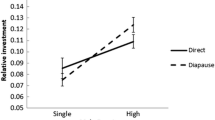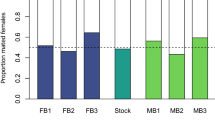Abstract
In arthropods, most cases of morphological dimorphism within males are the result of a conditional evolutionarily stable strategy (ESS) with status-dependent tactics. In conditionally male-dimorphic species, the status’ distributions of male morphs often overlap, and the environmentally cued threshold model (ET) states that the degree of overlap depends on the genetic variation in the distribution of the switchpoints that determine which morph is expressed in each value of status. Here we describe male dimorphism and alternative mating behaviors in the harvestman Serracutisoma proximum. Majors express elongated second legs and use them in territorial fights; minors possess short second legs and do not fight, but rather sneak into majors’ territories and copulate with egg-guarding females. The static allometry of second legs reveals that major phenotype expression depends on body size (status), and that the switchpoint underlying the dimorphism presents a large amount of genetic variation in the population, which probably results from weak selective pressure on this trait. With a mark-recapture study, we show that major phenotype expression does not result in survival costs, which is consistent with our hypothesis that there is weak selection on the switchpoint. Finally, we demonstrate that switchpoint is independent of status distribution. In conclusion, our data support the ET model prediction that the genetic correlation between status and switchpoint is low, allowing the status distribution to evolve or to fluctuate seasonally, without any effect on the position of the mean switchpoint.





Similar content being viewed by others
References
Arnqvist G, Nilsson T (2000) The evolution of polyandry: multiple mating and female fitness in insects. Anim Behav 60:145–164
Brockmann HJ (2008) Alternative reproductive tactics in insects. In: Oliveira RF, Taborsky M, Brockmann HJ (eds) Alternative reproductive tactics: an integrative approach. Cambridge University Press, Cambridge, pp 177–223
Burnham KP, Anderson DR (2002) Model selection and multimodel inference: a practical information-theoretic approach. Springer, New York
Buzatto BA, Machado G (2008) Resource defense polygyny shifts to female defense polygyny over the course of the reproductive season of a Neotropical harvestman. Behav Ecol Sociobiol 63:85–94
Buzatto BA, Requena GS, Martins EG, Machado G (2007) Effects of maternal care on the lifetime reproductive success of females in a neotropical harvestman. J Anim Ecol 76:937–945
Cook JM, Bean D (2006) Cryptic male dimorphism and fighting in a fig wasp. Anim Behav 71:1095–1101
Eberhard WG (1982) Beetle horn dimorphism—making the best of a bad lot. Am Nat 119:420–426
Eberhard WG, Gutierrez EE (1991) Male dimorphisms in beetles and earwigs and the question of developmental constraints. Evolution 45:18–28
Emlen DJ (1994) Environmental-control of horn length dimorphism in the beetle Onthophagus acuminatus (Coleoptera, Scarabaeidae). Proc R Soc Lond B Biol Sci 256:131–136
Emlen DJ (1997) Diet alters male horn allometry in the beetle Onthophagus acuminatus (Coleoptera: Scarabaeidae). Proc R Soc Lond B Biol Sci 264:567–574
Emlen DJ, Nijhout HF (2000) The development and evolution of exaggerated morphologies in insects. Annu Rev Entomol 45:661–708
Emlen DJ, Lavine LC, Ewen-Campen B (2007) On the origin and evolutionary diversification of beetle horns. Proc Natl Acad Sci USA 104:8661–8668
Forster RR (1954) The New Zealand harvestmen (sub-order Laniatores). Canterbury Mus Bull 2:1–329
Gadgil M (1972) Male dimorphism as a consequence of sexual selection. Am Nat 106:574–580
Gnaspini P (1995) Reproduction and postembryonic development of Goniosoma-spelaeum, a cavernicolous harvestman from southeastern Brazil (Arachnida, Opiliones, Gonyleptidae). Invertebr Reprod Dev 28:137–151
Gross MR (1985) Disruptive selection for alternative life histories in salmon. Nature 313:47–48
Gross MR (1996) Alternative reproductive strategies and tactics: diversity within sexes. Trends Ecol Evol 11:92–98
Hazel WN, Smock R, Johnson MD (1990) A polygenic model for the evolution and maintenance of conditional strategies. Proc R Soc Lond B Biol Sci 242:181–187
Hunt J, Simmons LW (2001) Status-dependent selection in the dimorphic beetle Onthophagus taurus. Proc R Soc Lond B Biol Sci 268:2409–2414
Knell RJ (2009) On the analysis of non-linear allometries. Ecol Entomol 34:1–11
Kokko H, Rankin DJ (2006) Lonely hearts or sex in the city? Density-dependent effects in mating systems. Philos Trans R Soc B-Biol Sci 361:319–334
Kotiaho JS, Tomkins JL (2001) The discrimination of alternative male morphologies. Behav Ecol 12:553–557
LaBarbera M (1989) Analyzing body size as a factor in ecology and evolution. Ann Rev Ecol Syst 20:97–117
Lebreton JD, Burnham KP, Clobert J, Anderson DR (1992) Modeling survival and testing biological hypotheses using marked animals—a unified approach with case-studies. Ecol Monogr 62:67–118
Machado G (2002) Maternal care, defensive behavior, and sociality in neotropical Goniosoma harvestmen (Arachnida, Opiliones). Insect Soc 49:388–393
Moczek AP (2002) Allometric plasticity in a polyphenic beetle. Ecol Entomol 27:58–67
Moczek AP (2003) The behavioral ecology of threshold evolution in a polyphenic beetle. Behav Ecol 14:841–854
Moczek AP, Emlen DJ (1999) Proximate determination of male horn dimorphism in the beetle Onthophagus taurus (Coleoptera: Scarabaeidae). J Evol Biol 12:27–37
Moczek AP, Nijhout HF (2003) Rapid evolution of a polyphenic threshold. Evol Dev 5:259–268
Munguía-Steyer R, Córdoba-Aguilar A, Romo A (2010) Do individuals in better condition survive for longer? Field survival estimates according to male alternative reproductive tactics and sex. J Evol Biol 23:175–184
Radwan J (1993) The adaptive significance of male polymorphism in the acarid mite Caloglyphus berlesei. Behav Ecol Sociobiol 33:201–208
Radwan J, Unrug J, Tomkins JL (2002) Status-dependence and morphological trade-offs in the expression of a sexually selected character in the mite, Sancassania berlesei. J Evol Biol 15:744–752
Repka J, Gross MR (1995) The evolutionary stable strategy under individual condition and tactic frequency. J Theor Biol 176:27–31
Shuster SM (2008) The expression of crustacean mating strategies. In: Oliveira RF, Taborsky M, Brockmann HJ (eds) Alternative reproductive tactics: an integrative approach. Cambridge University Press, Cambridge, pp 224–250
Shuster SM, Wade MJ (2003) Mating systems and strategies. Princeton University Press, New Jersey
Simmons LW, Tomkins JL (1996) Sexual selection and the allometry of earwig forceps. Evol Ecol 10:97–104
Taborsky M, Oliveira RF, Brockmann HJ (2008) The evolution of alternative reproductive tactics: concepts and questions. In: Oliveira RF, Taborsky M, Brockmann HJ (eds) Alternative reproductive tactics: an integrative approach. Cambridge University Press, Cambridge, pp 1–21
Tomkins JL (1999) Environmental and genetic determinants of the male forceps length dimorphism in the European earwig Forficula auricularia L. Behav Ecol Sociobiol 47:1–8
Tomkins JL, Brown GS (2004) Population density drives the local evolution of a threshold dimorphism. Nature 431:1099–1103
Tomkins JL, Hazel W (2007) The status of the conditional evolutionarily stable strategy. Trends Ecol Evol 22:522–528
Tomkins JL, Moczek AP (2009) Patterns of threshold evolution in polyphenic insects under different developmental models. Evolution 63:459–468
Tomkins JL, Simmons LW (1996) Dimorphisms and fluctuating asymmetry in the forceps of male earwigs. J Evol Biol 9:753–770
Tomkins JL, LeBas NR, Unrug J, Radwan J (2004) Testing the status-dependent ESS model: population variation in fighter expression in the mite Sancassania berlesei. J Evol Biol 17:1377–1388
Unrug J, Tomkins JL, Radwan J (2004) Alternative phenotypes and sexual selection: can dichotomous handicaps honestly signal quality? Proc R Soc Lond B Biol Sci 271:1401–1406
Vanacker D, Maes L, Pardo S, Hendrickx F, Maelfait JP (2003) Is the hairy groove in the gibbosus male morph of Oedothorax gibbosus (Blackwall 1841) a nuptial feeding device? J Arachnol 31:309–315
Warton DI, Wright IJ, Falster DS, Westoby M (2006) Bivariate line-fitting methods for allometry. Biol Rev 81:259–291
West-Eberhard MJ (2003) Developmental plasticity and evolution. Oxford University Press, Oxford
White GC, Burnham KP (1999) Program MARK: survival estimation from populations of marked animals. Bird Study 46:120–139
Willemart RH, Osses F, Chelini MC, Macías-Ordóñez R, Machado G (2009) Sexually dimorphic legs in a neotropical harvestman (Arachnida, Opiliones): ornament or weapon? Behav Proc 80:51–59
Williams BK, Nichols JD, Conroy MJ (2002) Analysis and management of animal populations. Academic Press, San Diego
Acknowledgments
We are grateful to the staff of Intervales State Park for logistical support and to R.L. Paiva, T.M. Del Corso, N. Leiner, C.F. Lerche, P.M. Nassar, and T.M. Nazareth for helping in the fieldwork. Dr. William G. Eberhard helped this study since the beginning, through enlightening conversations about male dimorphism. Previous versions of the manuscript received useful comments by Drs. Leigh W. Simmons, Joseph L. Tomkins, Marcelo O. Gonzaga, and two anonymous reviewers to whom we are very grateful. This work was supported by Fundação de Amparo à Pesquisa do Estado de São Paulo (FAPESP, grant numbers 02/00381-0, 03/05427-0, 03/05418-1, 08/53737-2, 09/50031-4), Coordenação de Aperfeiçoamento de Pessoal de Nível Superior (CAPES), and Conselho Nacional de Desenvolvimento Científico e Tecnológico (CNPq).
Author information
Authors and Affiliations
Corresponding author
Electronic supplementary material
Below is the link to the electronic supplementary material.
Supplementary material 1 (WMV 6058 kb)
Rights and permissions
About this article
Cite this article
Buzatto, B.A., Requena, G.S., Lourenço, R.S. et al. Conditional male dimorphism and alternative reproductive tactics in a Neotropical arachnid (Opiliones). Evol Ecol 25, 331–349 (2011). https://doi.org/10.1007/s10682-010-9431-0
Received:
Accepted:
Published:
Issue Date:
DOI: https://doi.org/10.1007/s10682-010-9431-0




